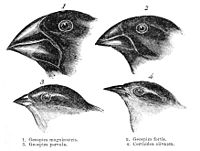
Photo from wikipedia
The biology of every species has been optimized for life in the environment in which that species evolved. Humans originated in the tropics, and while some natural selection took place… Click to show full abstract
The biology of every species has been optimized for life in the environment in which that species evolved. Humans originated in the tropics, and while some natural selection took place in response to behaviors and environments that decreased exposure to ultraviolet light, there has never been a species-wide biological accommodation. Paleolithic nutrition advocates argue that risk of disease is higher because modern diets differ from what was consumed by early humans. Early humans were the naked ape living in the tropics, exposed to high levels of ultraviolet light and vitamin D nutrition (serum 25-hydroxyvitamin D; 25(OH)D) averaging 115 nmol/L, as compared to today's population averages that are well below 70 nmol/L. Natural selection from an available gene pool cannot compensate fully to an environmental change away from the one within which the species originally evolved. Vitamin D nutrition remains a contentious area. The epidemiological evidence consistently relates lower 25(OH)D to higher disease risk. However, evidence from double-blind clinical trials looking at preventing new disease in healthy volunteers has been disappointing. But such negative trials have been the case for all nutrients except for folic acid which lowers risk of spina bifida. The Paleolithic nutrition model is based on fundamental biological concepts, but it has overlooked the environmental effects of ultraviolet light and vitamin D nutrition. This paper presents evolutionary and Paleolithic aspects of ultraviolet light and vitamin D with the aim to support pertinent research and, ultimately, public policy regarding nutrition and light exposure.
Journal Title: Advances in experimental medicine and biology
Year Published: 2020
Link to full text (if available)
Share on Social Media: Sign Up to like & get
recommendations!